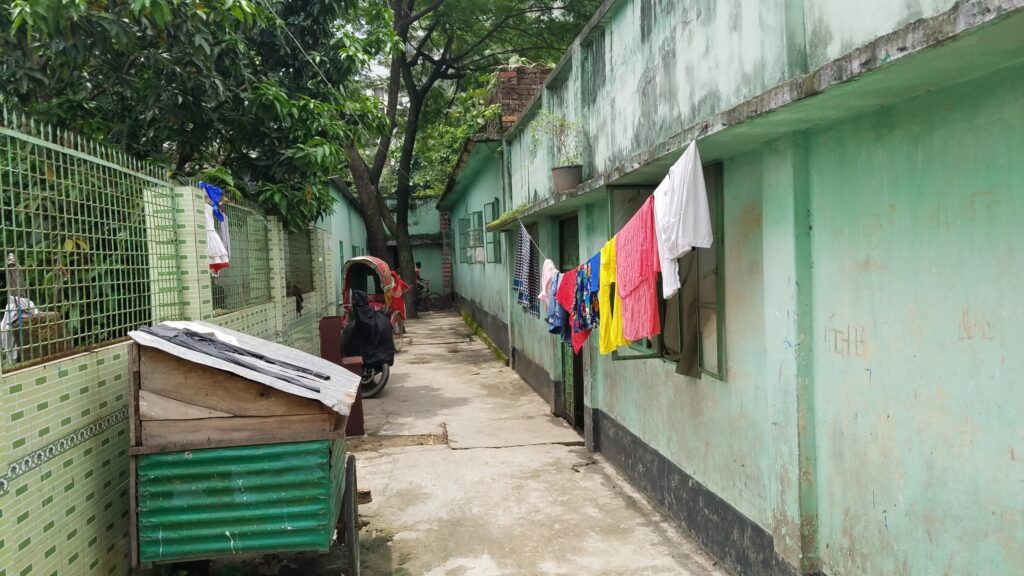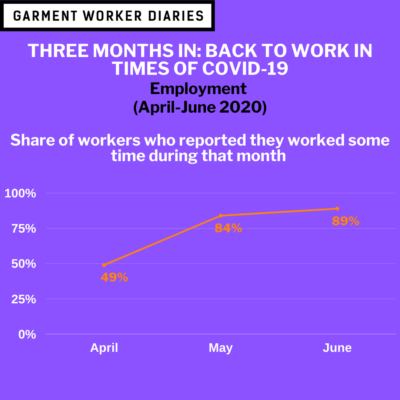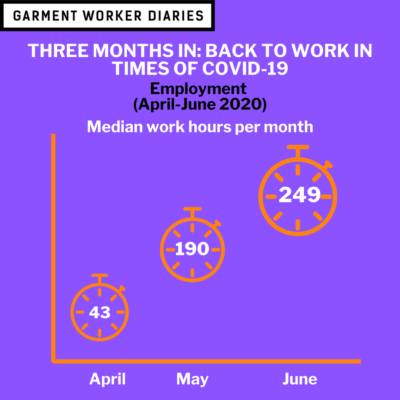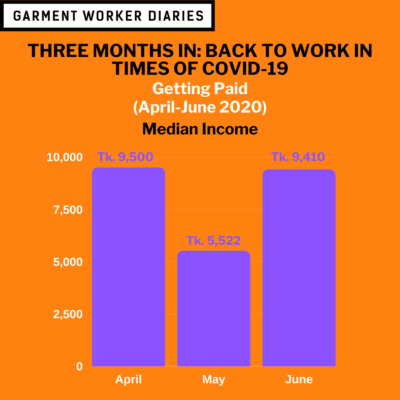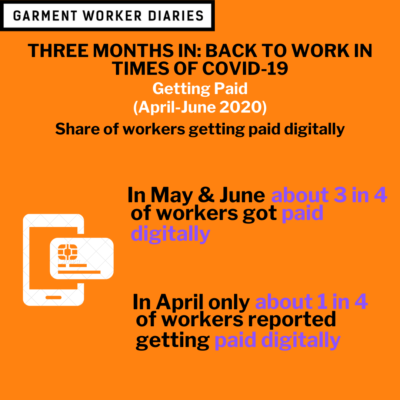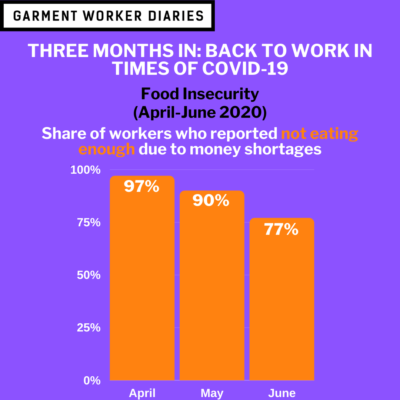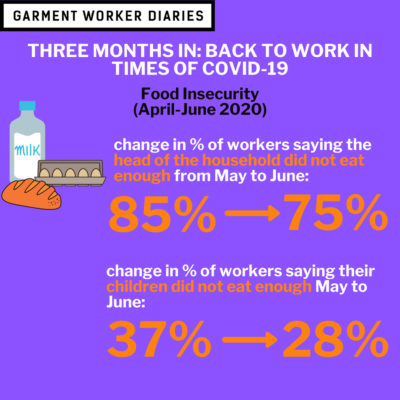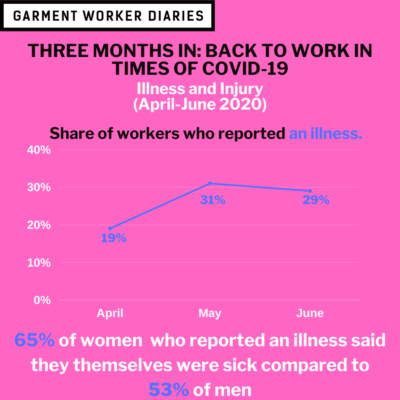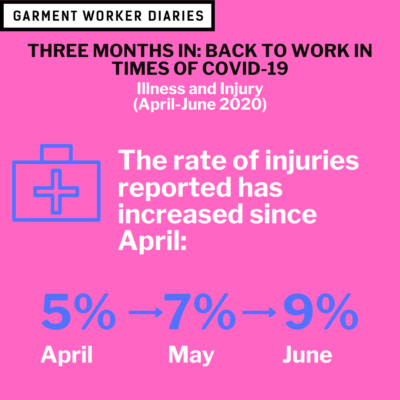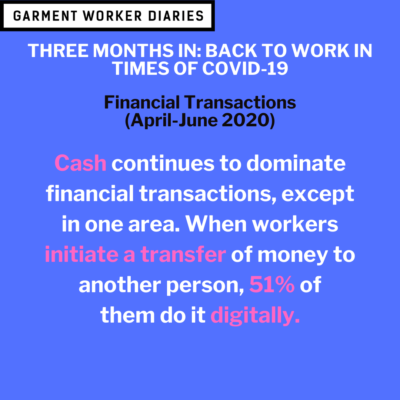Across the globe many countries are currently struggling with the impulse to return to business as usual while at the same time protecting the health and safety of their citizens. Bangladesh’s story, as told to MFO and SANEM by garment workers in the ready-made apparel sector, is no different.
It’s been four months now since the COVID-19 crisis hit Bangladesh, and we’ve analyzed full three months of data to see what impact the pandemic has had on the daily lives of garment workers. Here’s the full story for April, May and June 2020.
Employment
- In June 89% of garment workers reported they worked some time during that month. This is a slight increase over May (84% working), and a large increase over April (49% working)
- The proportion of workers who did not work in June and reported this as being due to a factory closure was about 1 in 4 in June (24%), down from about 1 in 2 (52%) in May
- Median work hours per month continued their sizable increase: 249 work hours comprised the median work month in June, up from 190 hours in May* and 43 hours in April
- The vast majority of respondents, 93%, lived in the city in June as opposed to the village, a number that has remained steady since May
*We previously reported the median work hours in May to be 174 hours. We have made adjustments in how we calculate work hours per month to bring them in line with the methodology used in our dashboard, which assigns hours to months in cases where a week straddles two months.
Getting Paid
- In June, 88% of garment workers reported that they received wages, a proportion which remained unchanged from April and May
- In June, the proportion of workers getting paid digitally was 77%, about the same as in May, but both considerable increases from the 28% of workers getting paid digitally in April.
- The median pay for June (Tk. 9,410), for work performed in May, returned to April levels (Tk. 9,500), for work performed in March, which are both much higher than the May median pay (Tk. 5,522), which was a mix of pay for work and pay under the government support scheme during the factory lockdown period.
- Women still earned less money than men in June, with the median pay for women Tk. 9,200 compared to Tk. 10,000 for men
Food Security
- Food insecurity decreased month-over-month as 77% of respondents in June reported that they ate less than they felt they should have due to lack of money (down from 90% in May and 97% in April)
- Women continue to report eating less than they feel they should than men: 79% of women reported they did not eat enough in June compared to 70% of men
- 75% of respondents reported that the head of the household did not eat enough in June, compared to 85% of respondents in May, an improvement
- Food security for children also improved in June: 28% of respondents reported their children did not eat enough in June compared to 37% in May
Illness and Injury
- The rate of illness reported by garment workers did not change much as 29% of respondents in June reported an illness in their household (compared to 31% in May)
- Both of these numbers are still noticeably higher than April, when just 19% of respondents reported an illness
- Women continued to self-report more instances of illness than men in June, as 65% of women who reported an illness in the household said it was they themselves who were sick, compared to 53% of men who said the same about themselves
- The vast majority of illness-reporting respondents, 96% in June, continued to say that they had sought medical attention, with similar proportions for women and men
- The rate of injuries reported has ticked up slightly since April: in April 5% reported an injury in the household; in May 7% did so; and in June 9% of respondents reported an injury in the household, again with the vast majority of injury-reporting respondents seeking medical attention
Financial Transactions
- Cash continued to dominate almost all financial transactions, with the exception of outgoing transfers: 51% of transfers to individuals outside their household were made digitally
- It seems respondents are more likely to take part in a digital transaction when the respondent is the originator of the transaction, as we see with loans given and loans received: in June, 24% of loans given were paid out digitally, compared to 7% of loans received that were digital
All data presented here come from interviews conducted over the phone with a pool of 1,377 workers. In April 2020, a total of 800 garment workers were enrolled in the study, and by the end of May 2020 this amount had grown to 1,377. The data received in May from the 800 workers that have been part of the sample since April, was compared with the data received from the full 1,377 sample and no discernible differences were found. For the June data, 1,341 workers were interviewed. These workers are employed in factories spread across the five main industrial areas of Bangladesh (Chittagong, Dhaka City, Gazipur, Narayanganj, and Savar). Just over three-quarters of the working respondents are women, roughly representative of workers in the sector as a whole.
